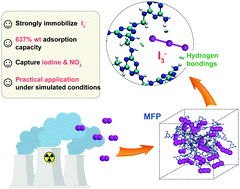Hydrogen bond-mediated strong adsorbent–I3− interactions enable high-efficiency radioiodine capture†
Abstract
Effectively capturing volatile radioiodine produced during the spent nuclear fuel reprocessing is an efficient way of the safe utilization of nuclear power. However, all the existing capture methods fail to immobilize radioiodine reliably due to the weak binding interaction between radioiodine and adsorbent, resulting in unstable binding sites and further iodine liberation. Herein, we report a pioneering approach to overcome this challenge by synthesizing a melamine-based polymer (MFP) with high binding energy to I3− species instead of the conventional I2 molecules. Both experimental and theoretical results confirmed that the iodine atoms of I3− strongly interact with MFP via synergistic hydrogen bonds. According to this, the highest binding energy to radioiodine was achieved (Gibbs free energy: −260.38 kcal mol−1, which was about four times stronger than that of the widely used Ag–I ion bond), enabling effective enrichment of volatile iodine without any iodine escape. The extraordinary energy not only allowed the MFP to capture iodine steadily and durably, but also afforded ultrahigh adsorption capacity (637 wt%, in iodine vapor). More interestingly, we found that the MFP showed promising results for removing NO2, which coexisted with iodine in the off-gas stream. To the best of our knowledge, this is the first attempt to remove both radioiodine and NO2. Last but not least, the MFP also exhibited satisfactory practical applications under simulated spent nuclear fuel reprocessing conditions.



 Please wait while we load your content...
Please wait while we load your content...